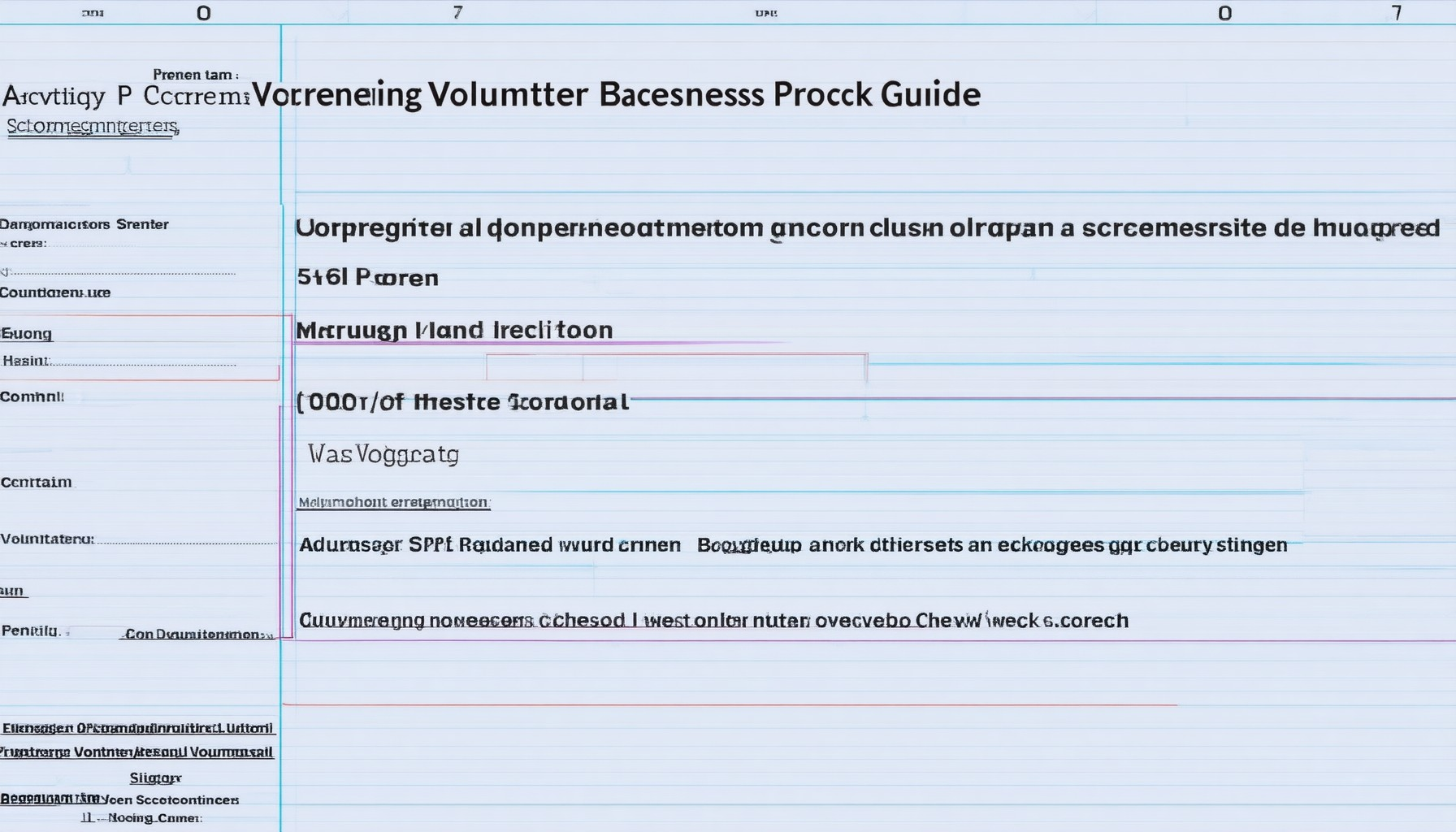Managing volunteers effectively is crucial for ensuring the success and reliability of your organization. When it comes to screening volunteers, it’s not just about finding individuals willing to donate their time—it’s about identifying those who are trustworthy, responsible, and aligned with your mission. A well-executed volunteer screening process can prevent potential conflicts, safeguard your organization’s reputation, and foster a safer environment for everyone involved. However, navigating the complexities of volunteer screening can be overwhelming, especially when considering the legal, ethical, and practical implications. Whether you’re a seasoned volunteer manager or new to the role, understanding the ins and outs of volunteer screening processes is essential for elevating your recruitment strategy. This guide dives into the key aspects of volunteer screening, offering insights, best practices, and real-world examples to help you create a robust screening program that ensures your volunteers are prepared, vetted, and ready to contribute positively to your cause.

How to Screen Volunteers
To effectively screen volunteers, follow a structured approach that ensures alignment with your organization’s values and goals. Here’s a comprehensive guide:
- Volunteer Intake Process
Begin with a clear intake process to gather essential information. Use a standardized form or application that includes personal details, background, and reasons for volunteering. This helps in assessing suitability early on. - Skill and Interest Assessment
Evaluate applicants based on their skills and interests relevant to the role. Consider creating a job description or application form that outlines the responsibilities and expectations. This ensures alignment between the volunteer’s capabilities and the organization’s needs. - Cultural Fit Evaluation
Assess cultural fit through a questionnaire or interview. Discuss shared values and beliefs to determine if the volunteer aligns with the organization’s mission and ethos, minimizing potential conflicts. - Reference Checks
Contact past employers or supervisors to verify reliability, work ethic, and suitability for the role. This provides insight into the volunteer’s character and previous performance. - Background Check
Conduct a background check if required by the role, particularly for positions dealing with sensitive information or working with vulnerable populations. - Legal and Policy Compliance
Ensure all volunteers are aware of and agree to the organization’s policies, including anti-discrimination, harassment, and child protection protocols. - Training and Orientation
Provide mandatory training sessions to cover expectations, policies, and procedures. This sets a foundation for behavior and performance standards. - Teamwork and Feedback Assessment
Evaluate teamwork abilities and willingness to receive feedback through assessments or observations during initial tasks. - Ongoing Evaluation and Support
Schedule regular check-ins to monitor engagement, alignment with goals, and overall performance. Offer support to enhance their contribution and satisfaction.
By systematically applying these steps, you can attract, screen, and retain volunteers who are not only skilled but also culturally and ethically aligned with your organization, fostering a cohesive and productive team.
What Are Screening Processes?
Screening processes are systematic methods used to evaluate and select candidates for roles within an organization. These processes help ensure that individuals are a good fit for the position and align with the company’s values, goals, and expectations. Below is a detailed breakdown of screening processes:
Key Components of Screening Processes
- Pre-Screening: This phase involves initial evaluations, such as resume reviews, cover letter analysis, and application forms. It ensures candidates meet basic qualifications before moving forward.
- Initial Screening: This may include interviews, behavioral assessments, or background checks. The goal is to gather enough information to assess the candidate’s fit for the role and the organization.
- Follow-Up Screening: Depending on the role’s complexity, further screenings, such as reference checks, skill assessments, or technical tests, may be conducted to validate the candidate’s abilities and past performance.
Steps to Implement Effective Screening Processes
- Define Clear Criteria: Establish specific requirements for the role to ensure consistency in evaluations. This helps in identifying the most suitable candidates.
- Use Assessments and Tests: Employ tools like personality tests, aptitude exams, or behavioral interviews to measure skills and fit. Tools like those offered on NPO Expert can aid in evaluating candidates effectively.
- Review Application Materials: Carefully examine resumes, cover letters, and other documents to gauge relevant experience and alignment with the organization’s mission.
- Conduct Reference Checks: Verify the candidate’s past performance and behavior through contacting previous employers or colleagues. This provides insight into their work ethic and cultural fit.
Importance of Screening Processes
Effective screening processes are vital for nonprofits to ensure they hire the right talent who can contribute meaningfully to their missions. By implementing robust screening practices, organizations can reduce turnover rates and enhance overall productivity. Resources from platforms like GreenBook and NonprofitSource offer valuable insights into optimizing hiring strategies.
Best Practices for Screening
- Stay Neutral: Evaluate candidates based on objective criteria rather than personal biases or preferences.
- Be Transparent: Communicate the screening process clearly to candidates to build trust and reduce frustration.
- Use Technology: Leverage tools and software to streamline the screening process and improve efficiency.
- Regularly Update Processes: Adapt screening procedures to reflect changing organizational needs and market demands.

What is a Screening Volunteer?
A screening volunteer plays a crucial role in evaluating potential volunteers to determine their suitability for specific roles within an organization. This process ensures that individuals are matched appropriately with the responsibilities they will undertake, fostering efficiency and effectiveness in the organization’s operations.
The screening process typically involves several steps, including but not limited to:
- Application and Background Check : Reviewing applications and conducting background checks to verify the candidate’s credibility and reliability.
- Interviews : Conducting interviews to assess the candidate’s skills, experience, and alignment with the organization’s values.
- Reference Checks : Gathering information from previous employers or colleagues to evaluate the candidate’s work ethic and performance.
- Skill Assessments : Administering tests or evaluations to measure the candidate’s relevant skills and abilities.
This structured approach ensures that the organization selects volunteers who are not only qualified but also motivated and capable of contributing positively to the team. Effective screening is vital for building a reliable and cohesive group of volunteers that can support the organization’s mission and goals.

How Long Does the Screening Process Take for a Job?
The screening process for a job varies depending on the role, industry, and organizational requirements. On average, the screening process can take anywhere from a few days to several weeks . Below is a breakdown of the typical stages and their estimated durations:
- Initial Application Review
- Duration: Typically less than 24 hours.
- During this phase, recruiters or hiring managers review your resume, cover letter, and any additional materials submitted with your application. They may also conduct an initial screening to determine if you meet the basic qualifications for the position.
-
Background Check
- Duration: Approximately 1-3 business days.
- This step involves verifying your employment history, education credentials, and any other information you’ve provided. Background checks may also include checking references, credit history, and criminal records.
-
Drug Test
- Duration: Usually completed within 24 hours of the application.
- Many employers require candidates to undergo a drug test as part of the screening process. The results are typically available quickly, often within a day or two.
-
Behavioral Assessments or Interviews
- Duration: Can vary significantly based on the company’s needs.
- Some companies may conduct behavioral assessments or interviews as part of the screening process. These may take a few days to schedule and complete, depending on the candidate’s availability.
-
Verification of Qualifications
- Duration: May take up to one week.
- Employers may request additional documentation to verify your qualifications, such as certifications, licenses, or proof of completion of specific training programs.
-
Final Candidate Selection
- Duration: Often takes a few days to a week.
- After completing all necessary screenings, the employer will review all candidates and select the most suitable individual for the position. This step may involve final interviews or reference checks.
Factors that can influence the length of the screening process include:
- Organization Size: Larger companies may have more complex screening processes due to higher volumes of applicants.
- Industry Standards: Certain industries, such as healthcare or finance, may have stricter regulations that require more thorough screening.
- Candidate Availability: If there are a limited number of qualified candidates, the process may move faster to accommodate scheduling constraints.
For more details on how to prepare for the screening process and to learn about best practices, visit our Screening Process Guide .
Does Pre-Employment Screening Mean You Got the Job?
No, pre-employment screening does not necessarily mean you have been offered the job. The screening process is a step in the hiring workflow, not a guarantee of employment. Here’s a breakdown of how it works:
- Purpose of Screening : Employers use screening processes to verify the accuracy of the information provided by candidates, check for any disqualifying factors, and ensure compliance with company policies. This includes background checks, reference verification, and sometimes drug tests.
- Hiring Process Timeline : Screening typically occurs after initial interviews and before extending a formal job offer. While it can sometimes lead to an offer, it is not the sole determinant of employment.
- Outcome of Screening : Candidates who pass the screening may proceed to receive a conditional job offer, subject to final approval. Those who fail may be rejected at this stage or moved to the next available position.
- Company Policies : Different companies may handle screening differently. Some may use it as a final step before confirming an offer, while others may incorporate it earlier in the process.
In summary, pre-employment screening is a crucial part of the hiring process but does not automatically result in a job offer. The actual offer is usually extended after completing all necessary steps, including screening.

How to Determine if Your Sterling Background Check Has Passed
To check the status of your Sterling background check, follow these steps:
- Email Communication:** Look for emails from Sterling with the subject line indicating the status of your background check. These emails often provide a clear update.
- Sterling Candidate Portal:** Log into the Sterling website using your candidate account. Navigate to the candidate portal where you can access your application status and background check details.
- Contact HR Department:** Reach out to the HR department for the most accurate and official update. They can provide direct information about your background check completion.
- Follow-Up Communication:** If you haven’t received updates, consider sending a polite follow-up inquiry to Sterling or the HR team. Provide necessary details to aid in tracking your application.
- Review Application Status:** Check the organization’s applicant tracking system (ATS) for any updates or notifications related to your background check status.
By systematically checking these avenues, you can efficiently determine whether your Sterling background check has been successfully completed.





0 Comments